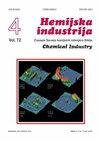Random mutagenesis and process optimization of bacterial co-culture for hyperproduction of 1, 4-α-D-glucan glucanohydrolase using submerged fermentation
IF 0.8
4区 工程技术
Q4 ENGINEERING, CHEMICAL
引用次数: 1
Abstract
The exponential increase in the application of 1,4-α-D-glucan glucanohydrolase (GGH) in various fields has placed stress and demand in both qualitative improvement and quantitative enhancement through strain improvement. In the present work, Bacillus subtilis LCBT-15 and Bacillus amyloliquefaciens LCBT-20 were subjected to physical as well as chemical mutagenesis for improving the GGH production potential. Applications of the UV light and ethidium bromide did not cause a significant increase in the enzyme production. However, Ethyl methane sulphonate (EMS) treated co-culture 10 gave 1.3-fold increase in the GGH production, in contrast to the wild co-culture. Different physicochemical parameters including fermentation media, rate of fermentation, temperature, pH, nitrogen and carbon sources and surfactants were also investigated. The M7 medium composition was optimized for GGH production after 48h of incubation at 37 o C and pH 6. The optimum inoculum size was 3.5 ml (1´10 6 cells/ml) in 50 ml of medium. The best carbon and nitrogen sources were lactose (2.5 %); ammonium chloride (1.75 %) and beef extract (1 %), respectively. Optimal GGH production (287 U/ml) was obtained when the medium was supplemented with 0.05% Tween 80. The novelty of this work was exploration of the synergistic phenomena of mutant bacterial co-culture for the enhancement of GGH production.细菌共培养深层发酵高产1,4-α-D-葡聚糖葡聚糖水解酶的随机诱变及工艺优化
1,4-α-D-葡聚糖葡聚糖水解酶(GGH)在各个领域的应用呈指数级增长,这给菌株改良带来了质量改良和数量改良的压力和需求。在本工作中,对枯草芽孢杆菌LCBT-15和解淀粉芽孢杆菌LCBT-20进行物理和化学诱变,以提高GGH的生产潜力。紫外线和溴化乙锭的应用并没有导致酶产量的显著增加。然而,与野生共培养物相比,甲烷磺酸乙酯(EMS)处理的共培养物10的GGH产量增加了1.3倍。研究了不同的理化参数,包括发酵介质、发酵速率、温度、pH、氮碳源和表面活性剂。在37℃和pH 6下培养48小时后,对M7培养基的组成进行了GGH生产的优化。在50 ml培养基中,最佳接种量为3.5 ml(1´10 6个细胞/ml)。碳和氮的最佳来源是乳糖(2.5%);氯化铵(1.75%)和牛肉提取物(1%)。当培养基中添加0.05%吐温80时,获得了最佳的GGH产量(287U/ml)。这项工作的新颖之处在于探索了突变细菌共培养提高GGH产量的协同现象。
本文章由计算机程序翻译,如有差异,请以英文原文为准。
求助全文
约1分钟内获得全文
求助全文
来源期刊

Hemijska Industrija
工程技术-工程:化工
CiteScore
1.60
自引率
11.10%
发文量
12
审稿时长
6-12 weeks
期刊介绍:
The Journal Hemijska industrija (abbreviation Hem. Ind.) is publishing papers in the field of Chemical Engineering (Transport phenomena; Process Modeling, Simulation and Optimization; Thermodynamics; Separation Processes; Reactor Engineering; Electrochemical Engineering; Petrochemical Engineering), Biochemical Engineering (Bioreactors; Protein Engineering; Kinetics of Bioprocesses), Engineering of Materials (Polymers; Metal materials; Non-metal materials; Biomaterials), Environmental Engineeringand Applied Chemistry. The journal is published bimonthly by the Association of Chemical Engineers of Serbia (a member of EFCE - European Federation of Chemical Engineering). In addition to professional articles of importance to industry, scientific research papers are published, not only from our country but from all over the world. It also contains topics such as business news, science and technology news, information on new apparatus and equipment, and articles on environmental protection.
 求助内容:
求助内容: 应助结果提醒方式:
应助结果提醒方式:


